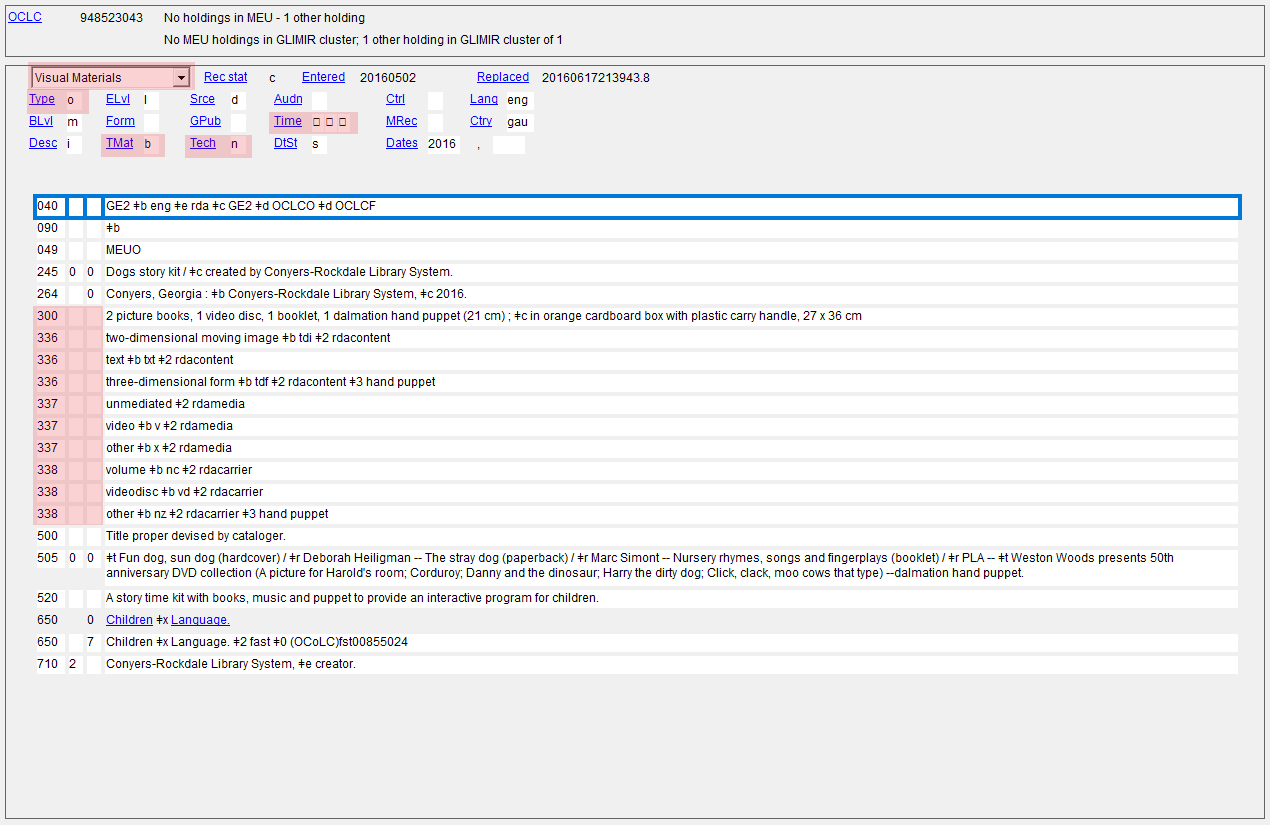Cataloging: Kits
Purpose: To provide an overview for the cataloging and processing of kits at Fogler Library.
Scope and Definition
Historically there were two categories of items which can be treated as kits:
- Items containing two or more types of materials, none of which is predominant;
- Single-medium package of textual materials primarily intended for instructional purposes.
Chief Source of Information
The chief source of information for kits is the whole item. Information can be taken from anywhere on the item (including the container).
Workform and Type Code
When working in Connexion, always use workform “visual materials” and Type code “o” when cataloging a kit.
(Note: you will find records on OCLC mistakenly using “p” (for mixed materials) when cataloging category 1 items and using “a” (for language materials) to catalog category 2 items.)
Other Fixed Fields Codes
007 Field
Apply the same rules and definitions to 007 fields used in kit records as you would to 007 fields used individually in other records. Use a separate 007 field for each group of materials (such as sound disc, sound cassette, filmstrip, and cards, etc.) in the package. DO NOT use 007 field for the book, booklets, game or teacher’s guide because no 007 fields apply. For more information, refer to OCLC Bibliographic Formats and Standards 007 Introduction.
300 Field
According to Nancy B. Olson’s Cataloging of Audiovisual Materials and Other Special Materials, there are three ways to formulate physical description. Apply whichever is appropriate. Consider what materials need to be accounted for when checking the kit in and out of circulation.
- Give the extent of each part or group of parts belonging to each distinct class of material as the first element of the physical description. Optionally, give the dimensions of the container. Example:
300 8 filmstrips, 4 sound discs, 18 charts and posters, 34 identical elementary booklets, 1 secondary booklet, 1 teacher’s guide ; $ in box 34 x 34 x 34 cm.
- Give a separate physical description on a separate line for each part or group of parts belonging to each distinct class of material. Example:
300 8 filmstrips : $b col. ; $c 35 mm. + $e 4 sound discs (analog, 33 1/3 rpm ; 12 in.)
300 8 charts : $b b&w ; $c 28 x 22 cm.
300 10 posters : $b col. ; $c 36 x 24 cm.
…
- Give a general term as the extent. Example:
300 28 various pieces ; $c in box 34 x 34 x 34 cm.
Other Variable Fields
Supply other variable fields where necessary. Pay special attention to 092, 245 and 949 fields:
- Staff in Technical Services assign DDC call numbers for the kits to be cataloged.
- The 33X fields should be used to note the various compenents. These fields are repeatable to take multiple formats into account. See links below for a current list of different types.
- In 949 filed command line for URSUS export:
I Type = 9 (kit)
Mat Type =e (EDU MATERIALS)
Location = olmc (Orono LMC)
Example: 94933*recs-b;ov-.o;b1-e;b2-o;b3-u;bn-olmcb;i-/sta-;ty-9/loc-olmc/i2-
Screenshots of Example Records (Partial)
The completed MARC record (OCLC# 948523043) can be used for deriving a new record or for creating constant data by searching in Connexion. Pay attention to highlighted fixed fields and variable fields.
CDs
As of 2012, kits which include a CD will have all parts (including the CD) located in a bag in the LMC.
Physical Processing
Apply a bar code to each item in the plastic bag and print out the labels (for each individual item as well as for the container).
Other Online Resources for Cataloging Kits
Video on cataloging Kits and 3D objects in RDA
NCSU Libraries College of Education Media Center Kits and Games
Special Libraries Cataloguing Kits Cataloguing Cheatsheet (33x fields discussed at bottom of page)
Return to the Technical Services TOC

